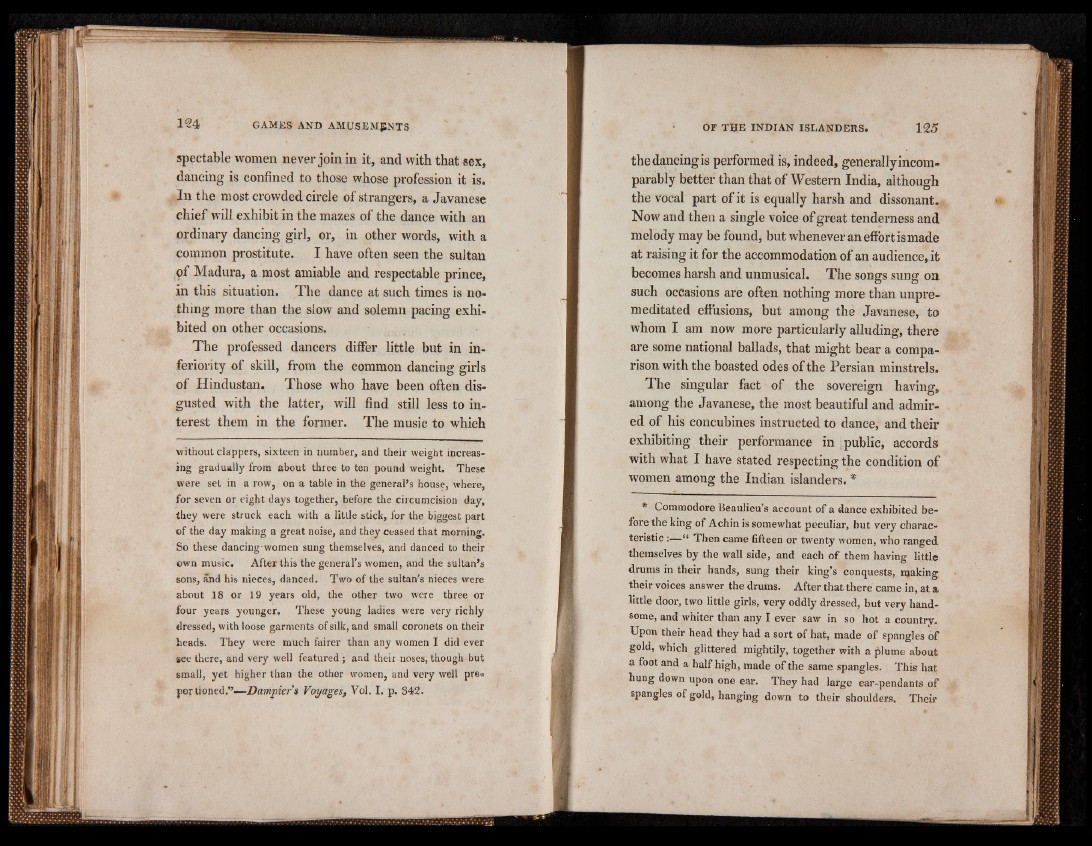
spectable women never join in it, and with that sex,
dancing is confined to those whose profession it is.
In the most crowded circle of strangers, a Javanese
chief will exhibit in the mazes of the dance with an
ordinary dancing girl, or, in other words, with a
common prostitute. I have often seen the sultan
of Madura, a most amiable and respectable prince,
in this situation. The dance at such times is nothing
more than the slow and solemn pacing exhibited
on other occasions.
The professed dancers differ little but in inferiority
of skill, from the common dancing girls
of Hindustan. Those who have been often disgusted
with the latter, will find still less to interest
them in the former. The music to which
without clappers, sixteen in number, and their weight increasing
gradually from about three to ten pound weight. These
were set in a row, on a table in the general’s house, where,
for seven or eight days together, before the circumcision day,
they were struck each with a little stick, for the biggest part
of the day making a great noise, and they ceased that morning.
So these dancing-women sung themselves, and danced to their
own music. After this the general’s women, and the sultan’s
sons, and his nieces, danced. Two of the sultan’s nieces were
about 18 or 19 years old, the other two were three or
four years younger. These young ladies were very richly
dressed, with loose garments of silk, and small coronets on their
heads. They were much fairer than any women I did ever
see there, and very well featured; and their noses, though but
small, yet higher than the other women, and very well preportioned.”—
Dampier's Voyagest Yol. I. p. 342.
the dancing is performed is, indeed, generally incomparably
better than that of Western India, although
the vocal part of it is equally harsh and dissonant.
Now and then a single voice of great tenderness and
melody may be found, but whenever an effort is made
at raising it for the accommodation of an audience, it
becomes harsh and unmusical. The songs sung on
such occasions are often nothing more than unpremeditated
effusions, but among the Javanese, to
whom I am now more particularly alluding, there
are some national ballads, that might bear a comparison
with the boasted odes of the Persian minstrels.
The singular fact of the sovereign having,
among the Javanese, the most beautiful and admired
of his concubines instructed to dance, and their
exhibiting their performance in public, accords
with what I have stated respecting the condition of
women among the Indian islanders.#
* Commodore Beaulieu’s account of a dance exhibited before
the king of Achin is somewhat peculiar, but very characteristic
:— “ Then came fifteen or twenty women, who ranged
themselves by the wall side, and each of them having little
drums in their bands, sung their king’s conquests, rqaking
their voices answer the drums. After that there came in, at a
little door, two little girls, very oddly dressed, but very handsome,
and whiter than any I ever saw in so hot a country.
Upon their head they had a sort of hat, made of spangles of
gold, which glittered mightily, together with a plume about
a foot and a half high, made of the same spangles. This hat
hung down upon one ear. They had large ear-pendants of
spangles of gold, hanging down to their shoulders. Their